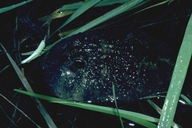|
Distribution and Habitat
Country distribution from AmphibiaWeb's database: Australia
Known from the north-western Kimberley region of Western, northern Northern Territory and into
Cape York Peninsula of Queensland. Also known from the Townsville region in Queensland.
The extent of occurrence of the species is approximately 772300 km2
Life History, Abundance, Activity, and Special Behaviors
Found in sparsely timbered savanna, sclerophyll woodland and grassland on clay soils. Spends
most of its life buried underground and emerges only after heavy rain when it can be found on
low-lying swampy ground which remains saturated after rain.
Breeds after heavy rains in shallow flooded areas. Males call whilst floating in water and their
bodies are inflated with air from their distended lungs. About 500 – 1400 eggs are laid in long
chains tangled in submerged vegetation. Tadpoles hatch and complete development in 8 weeks.
Trends and Threats
No known declines and extent of occurrence > 20,000km2.
Threats
None known.
Conservation Measures
None in place.
References
Barker, J., Grigg, G. C., and Tyler, M. J. (1995). A Field Guide to Australian Frogs. Surrey Beatty and Sons, New South Wales.
Cogger, H.G. (1992). Reptiles and Amphibians of Australia. Reed Books, New South Wales.
Tyler, M.J., Smith, L.A., and Johnstone, R.E. (1994). Frogs of Western Australia. Western Australian Museum, Perth.
Originally submitted by: Jean-Marc Hero et. al. (first posted 2002-04-05)
Edited by: Ambika Sopory (2008-09-24)Species Account Citation: AmphibiaWeb 2008 Notaden melanoscaphus: Northern Spadefoot Toad <https://amphibiaweb.org/species/3537> University of California, Berkeley, CA, USA. Accessed Apr 25, 2024.
Feedback or comments about this page.
Citation: AmphibiaWeb. 2024. <https://amphibiaweb.org> University of California, Berkeley, CA, USA. Accessed 25 Apr 2024.
AmphibiaWeb's policy on data use.
|
